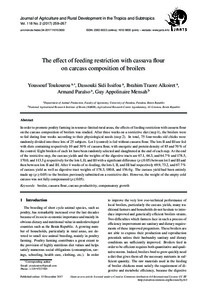Datum
2017-12-15Autor
Toukourou, YoussoufIssifou, Dassouki SidiAlkoiret, Ibrahim TraoreParaïso, ArmandMensah, Guy AppolinaireSchlagwort
630 Landwirtschaft, VeterinärmedizinMetadata
Zur Langanzeige
Aufsatz

The effect of feeding restriction with cassava flour on carcass composition of broilers
Zusammenfassung
In order to promote poultry farming in resource-limited rural areas, the effects of feeding restriction with cassava flour on the carcass composition of broilers was studied. After three weeks on a restrictive diet (step 1), the broilers were re-fed during four weeks according to their physiological needs (step 2). In total, 75 four-weeks old chicks were randomly divided into three lots of 25 subjects. Lot I (control) is fed without cassava flour. The lots II and III are fed with diets containing respectively 10 and 30 % of cassava flour, with energetic and protein density of 85 and 70 % of the control. Eight broilers of each lot have been randomly selected and slaughtered at the end of each step. At the end of the restrictive step, the carcass yields and the weights of the digestive tracts are 67.1, 66.3, and 64.7 % and 178.5, 170.0, and 113.3 g respectively for the lots I, II, and III with a significant difference (p ≤ 0.05) between lot I and III and then between lots II and III. After 4 weeks of re-feeding, the lots I, II, and III had respectively 69.9, 73.2, and 67.7 % of carcass yield as well as digestive tract weights of 178.3, 180.8, and 156.0 g. The carcass yield had been entirely made up (p ≥ 0.05) to the broilers previously submitted on a restrictive diet. However, the weight of the empty cold carcass was not fully compensated (p ≤ 0.05).
Zitierform
In: Journal of Agriculture and Rural Development in the Tropics and Subtropics. Kassel : Kassel University Press. - Vol. 118, No. 2 (2017) S. 259-267Sammlung(en)
Vol 118, No 2 (2017) (Journal of Agriculture and Rural Development in the Tropics and Subtropics (JARTS))Zitieren
@article{urn:nbn:de:hebis:34-2017110153650,
author={Toukourou, Youssouf and Issifou, Dassouki Sidi and Alkoiret, Ibrahim Traore and Paraïso, Armand and Mensah, Guy Appolinaire},
title={The effect of feeding restriction with cassava flour on carcass composition of broilers},
year={2017}
}
0500 Oax 0501 Text $btxt$2rdacontent 0502 Computermedien $bc$2rdacarrier 1100 2017$n2017 1500 1/eng 2050 ##0##urn:nbn:de:hebis:34-2017110153650 3000 Toukourou, Youssouf 3010 Issifou, Dassouki Sidi 3010 Alkoiret, Ibrahim Traore 3010 Paraïso, Armand 3010 Mensah, Guy Appolinaire 4000 The effect of feeding restriction with cassava flour on carcass composition of broilers / Toukourou, Youssouf 4030 4060 Online-Ressource 4085 ##0##=u http://nbn-resolving.de/urn:nbn:de:hebis:34-2017110153650=x R 4204 \$dAufsatz 4170 7136 ##0##urn:nbn:de:hebis:34-2017110153650
<resource xsi:schemaLocation="http://datacite.org/schema/kernel-2.2 http://schema.datacite.org/meta/kernel-2.2/metadata.xsd"> 2017-12-20T14:07:47Z 2017-12-20T14:07:47Z 2017-12-15 1612-9830 2363-6033 urn:nbn:de:hebis:34-2017110153650 http://hdl.handle.net/123456789/2017110153650 eng Kassel University Press Urheberrechtlich geschützt https://rightsstatements.org/page/InC/1.0/ broiler cassava flour carcass productivity compensatory growth 630 The effect of feeding restriction with cassava flour on carcass composition of broilers Aufsatz In order to promote poultry farming in resource-limited rural areas, the effects of feeding restriction with cassava flour on the carcass composition of broilers was studied. After three weeks on a restrictive diet (step 1), the broilers were re-fed during four weeks according to their physiological needs (step 2). In total, 75 four-weeks old chicks were randomly divided into three lots of 25 subjects. Lot I (control) is fed without cassava flour. The lots II and III are fed with diets containing respectively 10 and 30 % of cassava flour, with energetic and protein density of 85 and 70 % of the control. Eight broilers of each lot have been randomly selected and slaughtered at the end of each step. At the end of the restrictive step, the carcass yields and the weights of the digestive tracts are 67.1, 66.3, and 64.7 % and 178.5, 170.0, and 113.3 g respectively for the lots I, II, and III with a significant difference (p ≤ 0.05) between lot I and III and then between lots II and III. After 4 weeks of re-feeding, the lots I, II, and III had respectively 69.9, 73.2, and 67.7 % of carcass yield as well as digestive tract weights of 178.3, 180.8, and 156.0 g. The carcass yield had been entirely made up (p ≥ 0.05) to the broilers previously submitted on a restrictive diet. However, the weight of the empty cold carcass was not fully compensated (p ≤ 0.05). open access In: Journal of Agriculture and Rural Development in the Tropics and Subtropics. Kassel : Kassel University Press. - Vol. 118, No. 2 (2017) S. 259-267 Toukourou, Youssouf Issifou, Dassouki Sidi Alkoiret, Ibrahim Traore Paraïso, Armand Mensah, Guy Appolinaire Gedruckte Ausg. im Verlag Kassel Univ. Press (www.upress.uni-kassel.de) erschienen. </resource>
Die folgenden Lizenzbestimmungen sind mit dieser Ressource verbunden:
Urheberrechtlich geschützt

